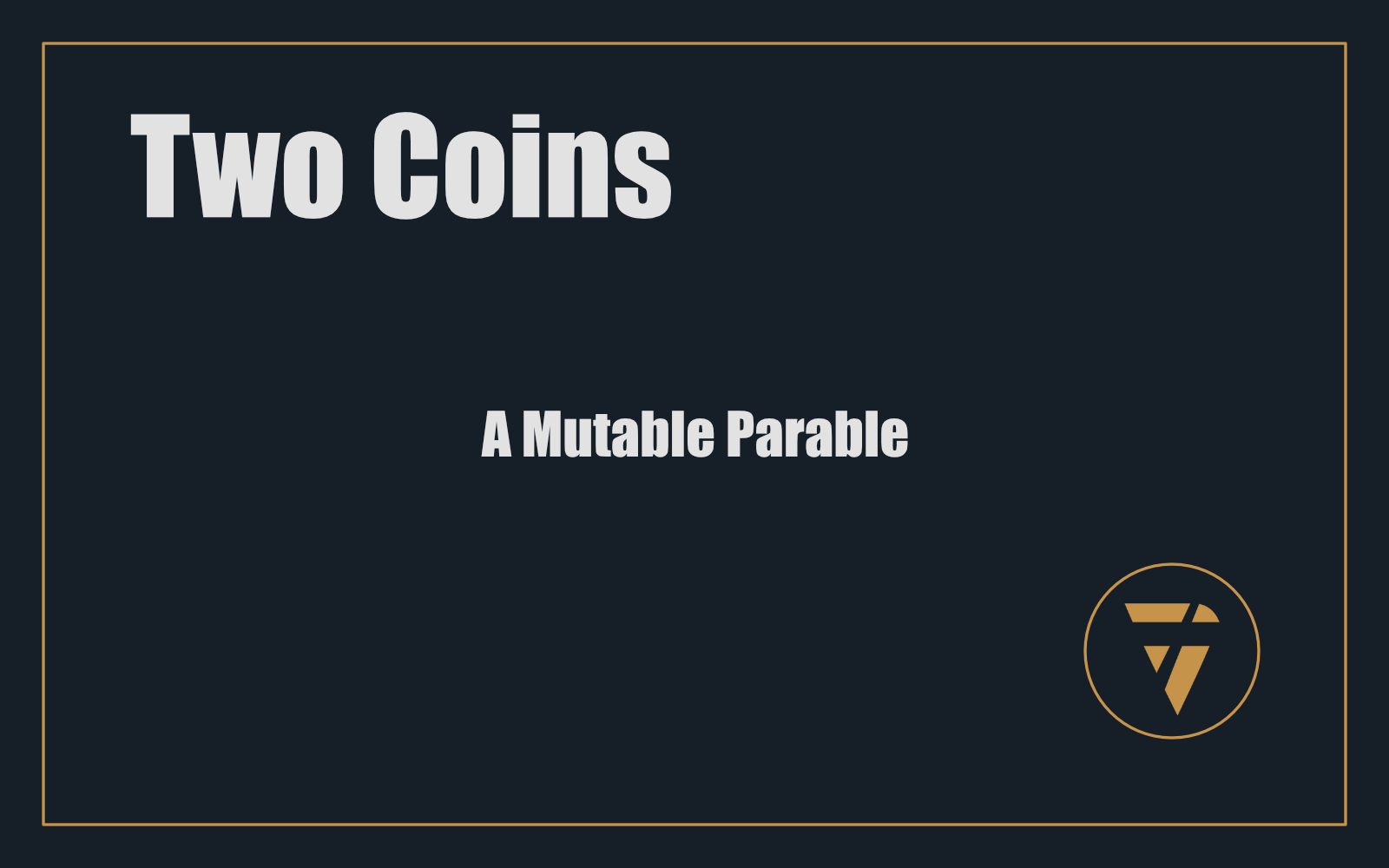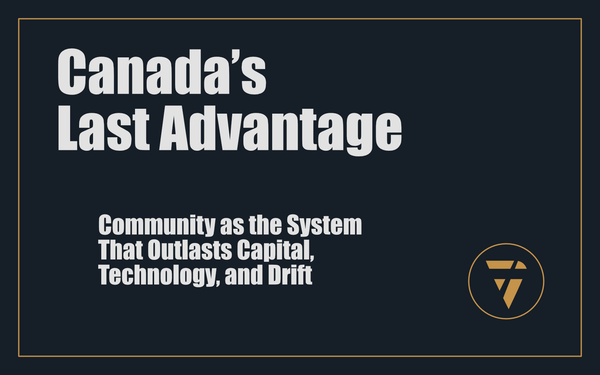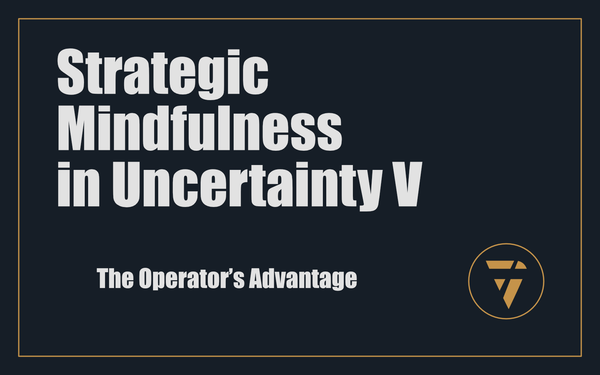Two Coins

The elder placed two coins on the table between them.
They were identical, save for the passage of time. One was slightly more worn than the other, as though it had passed through more hands, endured more pockets. But otherwise, they were the same. Same weight, same dull gleam, same ridged edges smoothed by use.
The student sat across from the elder, waiting.
"Take one," the elder said.
The student hesitated. "Which is the right one?"
The elder smiled, the kind of smile that offered nothing. "Whichever you believe is valuable."
The student frowned, leaning closer. "Are they different?"
The elder didn’t answer.
The student picked up one coin, rolling it between their fingers, feeling the slight unevenness of its edges. They set it down and took the other. The same weight, the same shape. Identical, yet not identical.
"How do I know which is real?"
The elder’s expression didn’t change. "You don't."
The student exhaled. They studied the coins again, searching for something… an engraving, a flaw, a subtle imbalance that would reveal the truth. But the truth did not reveal itself.
"Does it matter?" the student asked.
"Only if it matters to you."
The student pressed their lips together. "What happens if I choose wrong?"
The elder leaned back, folding their hands. "Then you will live with the choice."
The room was quiet but not silent. The soft sound of the wind through the open window. The occasional shifting of the elder’s robe. The distant murmur of the town outside.
The student closed their eyes. They reached out, fingers grazing the surface of the coins, feeling the cold metal, the slight texture of history.
Then they chose.
The elder nodded, as if that was all that had ever been required.
The student turned the coin over in their palm, waiting for something. Revelation, confirmation, consequence. But nothing happened.
"Is this the real one?" the student asked.
The elder’s voice was even, patient. "It is the one you took."
The student hesitated. "But…"
The elder raised a hand. "You chose. That is all."
The student stood, feeling the weight of the coin in their palm. It was a small thing. Insignificant. But somehow, it didn’t feel small at all.
They turned toward the door.
Behind them, the elder sat still. The remaining coin gleamed faintly in the light.
And as the student stepped out into the world, they realized…
They did not know if they had gained something, or if they had lost something, instead.
Before you continue... think about the story for a moment.

CONCEPT
Two Coins: A Mutable Parable
Ben Beveridge | Proconsul
A causal loop where the reader’s behaviour is shaped by an experience they didn’t consciously choose.
- Randomized Story Assignment
- Each time a reader accesses the story, they receive one of 10 versions at random.
- This ensures a unique, individualized experience.
- The Post-Story Action
- The final paragraph or closing line should contain a subtle nudge that suggests an action, decision, or realization.
- The key is to make the reader feel like they came to the decision organically, even though it was conditioned by the version they received.
- This action should be real-world applicable, not just a literary exercise.
- How the Changed Word Alters the Action
- If a version shifts the protagonist’s morality, the reader may be subtly prompted to reflect on a personal ethical choice.
- If the setting alters, they might be led to reassess their perception of where they physically are.
- If the final sentence suggests urgency vs. patience, they might take (or delay) an immediate real-life decision.
- If the version plays with trust vs. skepticism, the reader might be nudged to act differently toward someone in their life.
Implementation Mechanic:
- The closing passage could contain a question or directive that subtly encourages the reader to act.
- The reader might be presented with a follow-up action they must choose, without realizing that the story version influenced their selection.
- A post-reading interaction (a button, a decision, or even an external task) could lead to a secondary consequence.
Next Steps:
- Draft the core 800-word story.
- Identify 10 pivotal words that shift meaning/outcome.
- Map each version to a post-story action.
- Refine the closing paragraph to subtly nudge action.
Structural Notes & Why This Works for 10 Variations
- The ambiguity is deliberate. There is no confirmed "right" choice.
- The elder remains neutral. This allows any single-word shift to redefine the lesson.
- The student's uncertainty is the emotional anchor. The variations will either affirm, challenge, or subvert that uncertainty.
- The ending is open-ended, allowing reader reflection. This makes it easier for the final word change to shape their interpretation.
Next Steps: Mapping the 10 Variations
Each variation will change one key word or phrase to alter:
- What the elder implies about value, truth, or decision-making.
- How the student perceives the choice they made.
- How the reader interprets their own decision-making in real life.
Guide to Crafting a Mutable Short Story That Shapes Reader Action
This is a detailed guide to writing a short story that subtly influences real-world action based on the version a reader receives. It is designed to create an experience where the reader believes they are engaging with a fixed narrative, but in reality, they are receiving one of 10 possible versions, each with a single word change that fundamentally alters its meaning, emotional impact, or philosophical stance.
Unlike most interactive fiction, where the reader actively chooses a path, this story operates on randomized variation, the version they receive is beyond their control, yet their response is not. Instead, the outcome of their reading experience shapes an action they take afterward.
This is a psychological and literary experiment in how micro-changes in language influence human perception, belief, and decision-making.
I. Core Principles of the Project
1. Mutable Narrative, Fixed Action Framework
- The reader receives one of 10 versions at random.
- Each version differs by a single word, but that word is structurally critical. It shifts the meaning, outcome, or moral stance of the entire piece.
- The story itself does not explicitly change the action, instead, it plants a thought, emotional shift, or sense of urgency that causes the reader to choose a post-story action differently than they otherwise would.
2. The Psychological Mechanism at Play
This project explores how minor textual variations affect decision-making. A single word—when placed in the right structural position—can trigger shifts in:
- Ethical stance (e.g., justice vs. mercy)
- Emotional response (e.g., hope vs. dread)
- Perception of reality (e.g., illusion vs. truth)
- Sense of agency (e.g., action vs. inaction)
The key is that the reader should not be aware that the text they received was randomized, only that their response to it was personal and deeply felt.
II. The Writing Process
1. The Core Story (800 Words)
- The base narrative must be tight, self-contained, and thematically rich—capable of supporting multiple interpretations with minimal alterations.
- It should not rely on plot-heavy twists; instead, it should revolve around a central philosophical, ethical, or emotional question.
- It must end with a statement or moment of ambiguity—a final sentence that lingers, open-ended but suggestive.
Considerations for Theme:
- Moral ambiguity: A protagonist’s action is right in one version, wrong in another.
- Reality vs. perception: A shift in description alters what the reader believes to be true.
- Power and agency: A single word flips who has control in a given scene.
2. Selecting the 10 Critical Words
The most important structural step is identifying 10 single words that, when altered, shift meaning without breaking the story’s internal logic. These words should be:
- Emotionally charged: They must carry connotations that ripple outward.
- Central to theme: The word should be at a thematic fulcrum—ideally a verb, noun, or adjective that defines stakes.
- Subtly powerful: The change should be invisible unless compared side-by-side, yet undeniable in effect.
Examples of One-Word Changes That Alter Meaning:
- He watched her step forward. → He watched her hesitate. (Agency shift: confidence vs. doubt)
- The sky was a perfect blue. → The sky was an unnatural blue. (Perception shift: idyllic vs. artificial)
- She whispered, “I forgive you.” → She whispered, “I understand.” (Moral shift: absolution vs. neutrality)
- He let go. → He held on. (Action shift: surrender vs. resistance)
- The machine hummed, alive. → The machine hummed, aware. (Tone shift: mechanical vs. sentient)
Each change alters not just the story’s meaning, but the reader’s reaction to it.
3. Mapping the Word Change to Reader Action
The goal is not to tell the reader what action to take, but to subtly influence their decision-making process.
Each version of the story must:
- Create a slightly different emotional resolution.
- Frame a question or suggestion in a way that feels naturally derived.
- Implant a post-story “pull” that subtly nudges behavior.
Types of Reader Actions Influenced:
- Reflection: The story plants a lingering question, leading the reader to reconsider a past event.
- Decision: The story nudges the reader toward (or away from) taking a specific action in their real life.
- Emotion: The story leaves the reader feeling compelled to act on a feeling (reach out, hold back, wait, move forward).
4. Crafting the Closing Statement
- The final line should be resonant but ambiguous, forcing internal contemplation.
- It should not give explicit direction, but it should imply a response is required.
- The exact nature of that response should be dependent on the reader’s subconscious interpretation of the story version they received.
III. The Delivery Mechanic
Unlike traditional interactive fiction, the reader does not actively choose a path. Instead, the process works as follows:
- They access the story online.
- A random version is displayed (out of the 10 possible versions).
- They read without knowing that they are receiving a variation.
- The version they receive shapes how they interpret the ending.
- That interpretation subtly influences a real-life action they take next.
The key is deliberate obfuscation. The reader must never suspect the story is mutable, only that it made them feel something specific, which led to a decision.
In the context of this submission, the reader will understand that the experience is mutable, but they won’t know how.
IV. Final Execution Plan
1. Write the Base Story
- 800 words that are structurally strong, theme-driven, and open to interpretation.
2. Select & Integrate 10 Critical Word Changes
- Each change must be structurally invisible but psychologically profound.
3. Map How Each Change Alters Post-Story Response
- Ensure each version leads to a different reader perception, causing a subtle real-world action shift.
4. Implement the Randomization Mechanic
- Ensure that the reader cannot predict which version they will receive.
- Maintain a seamless reading experience where the variation remains hidden.
5. Track Reader Responses (Optional Experimental Layer)
- If desired, a follow-up prompt could gather data on post-story emotional state or intended actions.
- This would allow an analysis of how micro-shifts in language affect decision-making at scale.
V. Final Thoughts
This project is a fusion of literary experimentation, behavioural psychology, and interactive design. It goes beyond a simple “choose your own adventure” format. It introduces an invisible hand guiding human decision-making through micro-adjustments in language.
The reader never knows the mechanism, they simply react. The story is ephemeral, but its influence lingers.
If executed correctly, this creates not just a reading experience, but a behavioural experiment in real-time.
Next Steps:
- Write the core draft.
- Determine the 10 pivot words.
- Test different endings for action influence.
- Build the seamless delivery system.
When done right, this isn’t just a story.It’s a hidden machine, shaping perception and behaviour—without the reader ever knowing it was there.
"The Two Coins on the Table"
Core Premise:A wise elder places two identical coins before a student. One is real, one is false, but they are told to take whichever they believe is valuable.
This story is deceptively simple but structurally deep, allowing for subtle but meaningful shifts in reader perception and action.
Why This Story Works for 10 Versions:
- A Single Word Can Alter Reality or Perception
- What defines value? The object, the belief, the choice, or the outcome?
- Does the elder control the meaning, or does the student?
- Is the lesson about trusting one's own perception, or realizing all choices are arbitrary?
- Each Version Can Suggest a Different Type of Decision-Making Model
- Certainty vs. Doubt → Does the student hesitate or act?
- Materialism vs. Intuition → Is gold actually valuable, or is belief the only value?
- Free Will vs. Determinism → Was the choice ever really theirs?
- Consequence vs. No Consequence → Does it matter which coin was taken?
- The Outcome Directly Affects the Reader’s Post-Story Action
- Does the reader trust their instincts or second-guess their next decision?
- Do they become more confident in their choices or more skeptical of reality?
- Do they act quickly or hesitantly in their next interaction?
10 Versions & Their Subtle Shifts
Post-Story Influence on Reader Action
The beauty of this framework is that it allows each reader to unconsciously take away a different perspective, which will subtly guide their behaviour in the moments after reading.
- If they read a version where both coins are gold, they may make a decision quickly in their life, thinking that both options will be fine.
- If they read a version where only one coin was gold, they may hesitate, wondering if they are about to make the "wrong" choice.
- If the elder laughed, they may feel relief—like many of their worries are just games.
- If the coins changed, they may feel like all decisions are uncertain, leading to curiosity or existential doubt.
Final Execution Plan
- Draft the Core 800-Word Story.
- Write a version where the choice is the focus, not the outcome.
- Keep the ending open-ended enough to allow for different emotional interpretations.
- Embed the 10 Variations with Subtle Word Changes.
- Ensure each word swap fundamentally alters the theme but leaves the structure intact.
- Randomize the Version a Reader Receives.
- No visible indicator that they have received a different version than someone else.
- Test and Observe Post-Story Reactions.
- A follow-up prompt could track how the story influenced their thinking without them realizing.
Final Thought
"The Two Coins on the Table" is a perfect story for this experiment because:
- It appears simple but is actually profound.
- The core lesson shifts based on a single word, affecting how the reader thinks and acts after reading.
- The structure is highly flexible, allowing for 10 deeply different interpretations without needing a structural rewrite.
If executed correctly, this will not just be a short story.
It will be a quiet experiment in human perception, decision-making, and belief.
The Two Coins on the Table: 10 Variations & Their Impact
Each version below changes a single word or phrase, subtly but profoundly altering the lesson, tone, and psychological effect on the reader.
1. The Certain Choice
Changed Word: "You chose correctly." (Replaces "You chose. That is all.")
Effect on Story Meaning:
- The elder confirms that one coin was "right," shifting the story from subjective belief to objective truth.
- The student now feels relief instead of doubt—but it also introduces the fear that they could have been wrong.
Influence on Reader Action:
- Reader may feel reassured about their own past decisions.
- They may seek validation in their next real-life choice.
2. The False Choice
Changed Word: "It never mattered." (Replaces "It is the one you took.")
Effect on Story Meaning:
- The elder dismisses the importance of the decision entirely.
- The story shifts from a meditation on choice to a revelation of illusion—was the student ever really choosing at all?
Influence on Reader Action:
- Reader may question whether their choices truly matter.
- They may feel less pressure about upcoming decisions or more existential doubt.
3. The Vanishing Coin
Changed Word: "The remaining coin was gone." (Replaces "The remaining coin gleamed faintly in the light.")
Effect on Story Meaning:
- Adds mysticism or finality—did the other coin disappear, or was it never there?
- Introduces irreversibility—once chosen, the other path vanishes.
Influence on Reader Action:
- Reader may feel urgency in their next decision, realizing that some choices erase all others.
- Might lead to a stronger sense of commitment to current paths.
4. The Arbitrary Value
Changed Word: "It was worthless." (Replaces "It was a small thing. Insignificant.")
Effect on Story Meaning:
- Implies that the coin had no inherent value, shifting the story toward a commentary on constructed worth.
- The student now questions whether value is an illusion or simply assigned meaning.
Influence on Reader Action:
- Reader may reevaluate what they consider valuable.
- Might lead them to reconsider financial, emotional, or personal investments.
5. The Loss, Not the Gain
Changed Word: "They realized they had lost something." (Replaces "They did not know if they had gained something, or if they had lost something instead.")
Effect on Story Meaning:
- Shifts the ending into a parable about regret—choice always comes with loss.
- The focus is no longer on the decision itself, but on what was left behind.
Influence on Reader Action:
- Reader may reflect on opportunities they didn’t take.
- Could lead to hesitation before making a final decision.
6. The Infinite Choice
Changed Word: "There were always two coins." (Replaces "The remaining coin gleamed faintly in the light.")
Effect on Story Meaning:
- Suggests that the choice was not final, and that choice is constant, not singular.
- The lesson shifts to endless opportunity and adaptability.
Influence on Reader Action:
- Reader may feel empowered to correct or change decisions.
- They may become more open to revisiting past choices.
7. The Elder’s Judgment
Changed Word: "The elder sighed." (Replaces "The elder nodded.")
Effect on Story Meaning:
- The elder’s reaction implies disappointment or expectation.
- Now, the story questions whether the student’s choice was truly free, or if there was an expected answer.
Influence on Reader Action:
- Reader may feel pressure to meet external expectations.
- May cause self-reflection on whether their decisions are their own, or shaped by perceived judgment.
8. The Student’s Hesitation
Changed Word: "The student hesitated longer." (Replaces "The student hesitated.")
Effect on Story Meaning:
- Introduces fear into the choice, emphasizing overthinking and uncertainty.
- Changes the lesson from acceptance of choice to paralysis by doubt.
Influence on Reader Action:
- Reader may hesitate more in their own decision-making.
- May lead to an awareness of when they are overanalyzing.
9. The Quiet End
Changed Word: "The elder said nothing." (Replaces "The elder raised a hand.")
Effect on Story Meaning:
- Removes any validation, lesson, or acknowledgment of choice.
- Turns the story into a parable about solitude and self-trust—the elder will not guide the student beyond this point.
Influence on Reader Action:
- Reader may stop seeking external confirmation for choices.
- Could lead to a sense of self-sufficiency or isolation.
10. The Disrupted Expectation
Changed Word: "The elder laughed." (Replaces "The elder nodded.")
Effect on Story Meaning:
- Changes the tone into mockery, absurdity, or joy.
- The lesson shifts to not taking choices so seriously, as everything is ultimately a game.
Influence on Reader Action:
- Reader may release anxiety about big decisions.
- Might lead to a more playful or detached approach to life’s challenges.
Final Execution Plan
Now that we have the 10 variations, the final steps are:
- Embed these variations into the digital delivery system so that a reader receives one at random.
- Ensure there is no visible indicator that the story has multiple versions, this allows them to unknowingly experience its influence.
- Observe and test how different readers react, possibly through a follow-up reflection question.
This one short story, altered by one word per version, can shape how a reader views decision-making, perception, and value in their own life.
Question to the Reader:
"Which coin did you take?"
Why This Works:
- It forces the reader to commit to a choice, even though they never physically took a coin.
- Their answer will reveal how the version they read shaped their perception of value, certainty, or doubt.
- It exposes influence without revealing the mechanism. They will assume they made a free choice, but their version subtly guided them toward it.
- It ensures reflection, if they struggle to answer, they will start questioning why they feel one way or the other.
How Different Versions Will Elicit Different Responses:
- If they read the “Both are gold” version → They may confidently say “It doesn’t matter” or “Either one”.
- If they read the “One is worthless” version → They may hesitate, second-guessing themselves.
- If they read the “The remaining coin was gone” version → They may feel an urgency, as if their choice erased something.
- If they read the “The elder sighed” version → They may question if they made the “wrong” choice.
- If they read the “The elder laughed” version → They may see the entire decision as absurd, answering in a playful or dismissive way.
Follow-Up Option:
If you want to push them further, you could include a second question:
"Why did you choose that one?"
This will force them to rationalize their answer, and that’s when they may realize the story shaped their reasoning.
Would you like to collect and compare responses, or simply let readers walk away, carrying their unseen influence into the real world?
Final Question to the Reader:
"Was the choice ever really yours?"
Why This is the Perfect Question:
- It forces an existential realization, not just about the story, but about all choices they make.
- It exposes the influence without explaining it, making them question whether their reasoning was their own.
- It ties into every variation:
- If they read a version implying certainty, they might answer “Yes.”
- If they read a version implying illusion, they might answer “No.”
- If they read a version implying regret, they might struggle to answer at all.
- It creates a ripple effect beyond the story. The more they think about it, the more they’ll begin to apply the question to their real-world decisions.
How the Question Reveals Influence:
- If they confidently say “Yes” → Their version reinforced self-trust.
- If they hesitantly say “No” → Their version planted doubt about free will.
- If they struggle to answer → Their version disrupted their certainty without them realizing how.
This question works because no matter what they answer, they have already been influenced.
Would you like to collect responses secretly to study the unconscious shifts in thinking, or leave the question as an open-ended psychological trap they carry into their daily lives?
The Final Moral Test
"Would you rather make a choice and be wrong, or never choose at all?"
Why This Works as the Ultimate Test of Influence:
- It forces the reader to commit to a personal philosophy, without realizing it was shaped by the story they received.
- It exposes their unconscious response to risk, agency, and consequence.
- It is a direct reflection of the student’s dilemma in the story, mirroring their internal debate, but now applied to the reader’s own moral framework.
How Different Story Variations Will Lead to Different Answers:
- If they read a version reinforcing certainty → They will likely say, "Make the choice, even if it's wrong."
- If they read a version reinforcing hesitation → They may struggle to answer, or say, "It’s better not to choose at all."
- If they read a version suggesting illusion → They may say, "It doesn’t matter, because the choice was never real."
- If they read a version implying loss → They may feel anxious about the question, realizing they may have already lost something by choosing.
Why This Question is the Perfect Gauge of Influence:
- It makes them expose their internal belief shift—without realizing it was planted in them.
- It presents them with a moral paradox they now have to resolve, influenced by the framing of the version they read.
- It doesn’t ask whether the story influenced them—it makes them unknowingly prove that it did.
Would you like this question to be:
- A silent test they carry away unknowingly (where they answer internally and walk away changed)?
- A measurable experiment (where we collect responses to track how philosophical positions shift based on story variations)?
This is the moment where the hidden machine is revealed—but only to those who realize they were inside it all along.
This is what I’m working on. Tell me what you think, I enjoy the conversation! Subscribe and follow the work in real time.
Thanks!
B

You didn’t choose wrong. You just don’t know which version of the story you were given.
Perception is engineered. Belief is installed.
What you call intuition might be a single word... swapped upstream.
PS -






